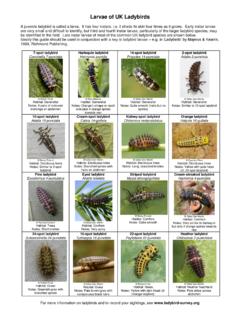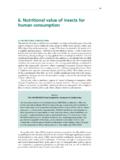Transcription of Guide to the identification of Wood-boring insects
1 Guide to the identification of Wood-boring insects Safeguard Chemicals Ltd., Redkiln Close, Horsham, West Sussex, United Kingdom. RH13 5QL. Tel: 01403 210204 Introduction This Guide has been produced in response to requests by property owners for an easy-to-use Guide for identifying Wood-boring insects native to the United Kingdom. In its current state, it allows the identification of species of wood- boring insects , and indicates whether or not treatment is necessary. Where treatment is necessary, our technical department should be called on 01403 210204 for advice on the most appropriate method of treatment. We intend to produce an expanded version of this Guide to include sections on ascertaining whether infestations are active, and giving detailed information on the different methods of treatment available.
2 Credits We would like to thank the Property Guarantee Administration (tel 0870 6071610) for their help in producing this Guide . The PGA offer insurance-backed guarantees for damp-proofing, timber treatment, and tanking. Details are available on the PGA website, Further Reading Guides to Rising damp and its Control and Dry Rot and its Control are available for download from the Safeguard website at Safeguard Chemicals Ltd 2003. COMMON FURNITURE BEETLE WANEY EDGE BORER. (Anobium punctatum) (Ernobius mollis). Timbers attacked Timbers attacked Sapwood of hardwoods and softwoods, plywood, Partly or fully seasoned softwoods with bark wattling. present. Damage Damage Confined to the bark with very superficial Tunnelling in sapwood tends to run along the tunnelling in the outer sapwood; emergence grain.
3 Tunnels relatively short and contain a loose holes rarely further than 15mm from barked bore dust. Bore dust feels 'gritty', and under area. Holes about 2mm in diameter. Bore magnification it is uniform in colour and contains dust 'gritty' feel; small 'bun-shaped' light 'lemon' shaped pellets. and dark coloured pellets. Exit holes are round, about - 2mm diameter. Life cycle (1 - 2 years). i. Adult : Emerge May - August Life cycle (3+ years) and lay eggs. i. Adult: Emerge May to August ii. Eggs: Laid in bark; white, lemon shaped. and mate iii. Larva: Bores and grows first in ii. Eggs: Laid in cracks, crevices, bark; may also end grain, old exit holes; superficially attack outer white, lemon shaped.
4 Sapwood and this gives iii. Larva: Bores straight into wood rise to the dark and light from egg: feed and grow coloured pellets. for 3 or more years. iv. Pupa: Develops in bark/. Larvae reach 6mm in length. sapwood interface 10. iv. Pupa: Develop below surface of days before emergence. wood. Pupal stage is 6-8. weeks prior to emergence. Notes: Damage is mistaken for Common Furniture Notes: Beetle damage. Waney Edge Borer must Damage can be confused with Ambrosia beetle, have bark present. Waney Edge Borer and Weevil. DOES NOT NEED TREATMENT. Quick identification : Quick identification : Bark present; bun-shaped pellets in bore dust Short tunnels, lemon shaped pellets present in which are dark and light in colour.
5 Holes in bark gritty bore dust. or close sapwood. AMBROSIA BEETLES DEATHWATCH BEETLE. (Platypodidae, Scolytidae) (Xestobium rufuvillosum). Timbers attacked Timbers attacked Hardwoods and softwoods Sapwood and heartwood of hardwoods, usually oak, which have partly decayed. Softwoods are Damage rarely attacked. The damage occurs in the forest, the insects attacking standing trees and freshly felled logs, Damage tunnelling into the wood for long distances Extensive tunnelling especially towards centre across the grain. No bore dust. Unlike most of large dimensioned timber. Exit holes are woodborers the adult does the tunnelling. round, 3mm diameter. Bore dust is bun-shaped and contains pellets visible to the naked eye.
6 Surface of tunnels are coloured black/blue-black. Holes vary in size depending on which of the Damage often more extensive than expected Ambrosia beetles caused the damage; many from external appearance. about the same size as furniture beetle holes. Life cycle (4+ years). Life cycle: i. Adult: Emerge March - June;. Varies according to which species of Ambrosia eggs laid 10-20 days after beetle infested the log. mating. ii. Eggs: Laid in cracks and crevices;. Notes: white, lemon shaped. The damage is usually confused with Common iii. Larva: Crawl prior to boring into Furniture Beetle damage but it occurs in the log. wood; feed and grow for These insects cannot infest seasoned timber.
7 Up to 12-14 years. DOES NOT NEED TREATMENT. iv. Pupa: Develop below surface of wood in July - August. Pre-emergent adults wait in pupa chamber until following year Notes: Adult beetles can often be found on and beneath infested timbers during emergence period. Will fly but require high temperatures. Quick identification : No bore dust; holes run across the grain long distances (pin test - c/f Common Furniture Beetle). Surface of tunnels coloured black/blue-black. Since the damage occurred in the log converted wood often cuts holes at an angle which makes Quick identification : them look elongated. Large bun-shaped pellets; attacks hardwoods. WOOD boring WEEVILS POWDER POST BEETLE. (Pentarthrum huttoni, Euophryum confine) (Lyctus brunneus).
8 Timbers attacked Timbers attacked Any wood that is decayed. Sapwood of seasoned wide-pored hardwoods with a high starch content. Timbers over 15 years Damage old not attacked. Tunnels run along the grain just below surface, often exposed. Coarse bore dust, 'gritty' feel. Damage Emergence holes are round but with ragged Tunnels tend to run along grain; often causes edges. Damage caused by both larvae and adults, 'surface' tunnelling where timbers are stacked. both of which may be found in infested wood. Tunnels filled with loose flour-like dust. Round emergence holes 1-2mm diameter. Life cycle (7-9 months). i. Adult: Live up to 16 months Life cycle (1-2 years outdoors; 8-10 months and feed on wood with indoors).
9 Larvae. i. Adult: Emerge outdoors July - ii. Eggs: White, laid on or just August; anytime indoors. below surface. ii. Eggs: Laid down open vessels;. iii. Larva: Curved shape, white. white, elongated with Bore extensively along tail. Hatch in 2-3 weeks. grain. Present for 8-9. months. iii. Larva: Initially feed and bore along grain. iv. Pupa: Develops just below surface. iv. Pupa: White; looks more like a beetle than a larva. Notes Where weevil damage occurs it is a secondary Notes problem; fungal decay is the primary concern. Unlikely to be found in the average domestic environment. Usually a problem in timber yards or stores of hardwoods, , furniture factories. Where found in a building the origin is usually from such storage areas.
10 Can be confused with Furniture Beetle damage. Quick identification Ragged exit holes; coarse bore dust, tunnels run along grain often breaking the surface. Always in Quick identification association with fungal decay. Hardwoods; loose flour-like frass. HOUSE LONGHORN BEETLE FOREST LONGHORNS. (Hylotrupes bajulus) (Family: Cerambycidae). Timbers attacked Timbers attacked Sapwood of seasoned softwood. Softwoods and hardwoods; standing trees, freshly felled and partly dried barked timbers. Damage Very severe tunnelling in sapwood; can lead to Damage structural collapse. Frequently only a thin surface These form a large group of insects and so veneer of sound wood remains. Exit holes are damage varies in extent and size.






